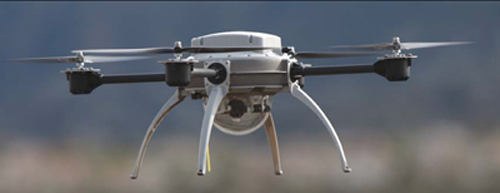has announced several improvements to its Scout unmanned aircraft, including two new payloads and structural enhancements that make the device more durable and sturdier.
Regarding the payloads, the company has added a 10X optical zoom camera, and a 5-megapixel “workhorse” camera, said Chris Barter, Scout product manager. The latter is designed for instances where image clarity isn’t an issue, for example when a SWAT team merely wants to monitor the movements of suspects before its members enter a structure, but doesn’t need to know exactly who they are. The new cameras supplement the legacy 5- and 10-megapixel daylight and infrared cameras that take both video and still images.
Meanwhile, the idea for the optical zoom camera came from a customer that clearly was interested in image clarity, Barter said. “They wanted to be able to look at a person on the ground, from a reasonable distance, and determine if they were holding a rake or an AK-47,” Barter said. “You could take an image and then blow it up digitally, but the resolution of the optical-zoom camera is far better. You can see what people are doing from two kilometers away.” He added that this camera also can be used for facial and license-plate recognition, within a range of about 571 yards.
All of the cameras utilise a two-axis gimbal to keep image images steady when the UAV encounters high winds. Regarding such conditions, Datron has added carbon fibre to the UAV’s rotor blades. “The carbon fibre stiffens the blades so that they don’t warp,” Barter said. “It has a wind threshold of [37 mph], but I’ve seen it fly in gusts up to [53 mph].”
In addition, the cameras are housed in a new streamlined and rugged plastic housing that replaces the previous clear plastic bubble. “This makes Scout more aerodynamic,” Barter said. “As a result, it uses less power.” That in turn lets the lithium battery-powered drone fly longer.
A heat sink has been added to protect the aircraft’s components in very hot climates. According to Barter, the drone can operate in temperatures as high as 131 degrees F. “The cooler it is, the better its electronics work,” he said. In addition, the drone’s brushless DC electric motor — which is so quiet that it can fly as low as 66 feet above the target without being heard — now is encased in a plastic housing designed to keep it dry.
As in the previous version, the aircraft is controlled by a tablet PC using a point-and-touch interface. Software upgrades include a GPS-driven “follow me” application. “Let’s say that you need constant surveillance of a convoy,” Barter said. “The Scout now can follow the convoy automatically.”
The aircraft also features a new mapping application that the military — and perhaps law enforcement — should find quite useful, Barter said. Images from Scout can be imported into a map-tile engine to quickly create up-to-date maps. “Maps often are out of date,” he said. “Let’s say that you roll up on a building that isn’t on any of the maps you have. You can use images taken by Scout to create a more accurate map.”
In other news, Datron recently introduced a quick-to-deploy IP-based solution dubbed “Safari” that features a wireless network controller router that enables interconnection of disparate licensed and unlicensed HF, VHF and Project 25 radios. In addition, multiple boxes can be deployed at an emergency scene to create a self-healing mesh network, said Bruno Haineult, the company’s director of government solutions.
Haineult added that Safari is housed in a temperature-controlled rugged container called a “rhino box.” A microprocessor opens or closes vents as needed. When the vents are open, they circulate air. When they are closed, the insulated box retains the heat generated by Safari’s various components. Safari can operate on AC or DC power, and will switch automatically to the latter should AC power be lost. In addition, it can operate on solar power. “You could put it on the top of a hill or mountain and forget about it for the duration of your mission,” Haineult said.
Source: Press Release

